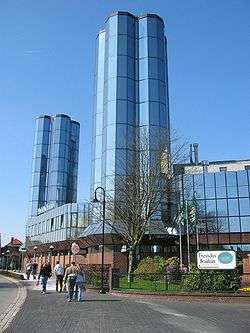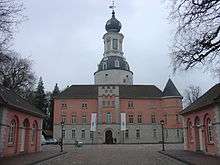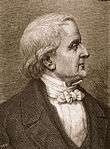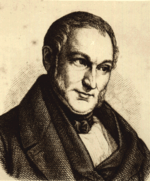Jever
Jever (German pronunciation: [ˈjeːfɐ]; the pronunciation [ˈjeːvɐ] is often heard from non-locals) is the capital of the district of Friesland in Lower Saxony, Germany. The name Jever is usually associated with a major brand of beer which is produced there. The city is also a popular holiday resort. Jever was granted city status in 1536. Unofficially Jever is sometimes referred to as Marienstadt (Maria city) in reference to Maria of Jever, the last independent ruler of the city. The inhabitants of Jever are named Jeveraner.
Jever | |
|---|---|
 The Friesisches Brauhaus, where Jever beer is brewed | |
 Coat of arms | |
Location of Jever within Friesland district   | |
 Jever  Jever | |
| Coordinates: 53°34′28″N 7°54′03″E | |
| Country | Germany |
| State | Lower Saxony |
| District | Friesland |
| Government | |
| • Mayor | Jan Edo Albers (Ind.) |
| Area | |
| • Total | 42.13 km2 (16.27 sq mi) |
| Elevation | 9 m (30 ft) |
| Population (2018-12-31)[1] | |
| • Total | 14,301 |
| • Density | 340/km2 (880/sq mi) |
| Demonym(s) | Jeveraner |
| Time zone | CET/CEST (UTC+1/+2) |
| Postal codes | 26441 |
| Dialling codes | 04461 |
| Vehicle registration | FRI |
| Website | www.stadt-jever.de |
Mayors
- 1972-1975: Horst Dutge
- 1975-1976: Paul Müller
- 1976-1985: Paul Sillus
- 1985-1986: Heinz Behrends
- 1986-1996: Siegfried Harms
- 1996-2001: Margot Lorentzen
- 2001-2005: Siegfried Harms
- 2005-2013: Angela Dankwardt
- since 2013: Jan Edo Albers
History

Archaeological findings in the vicinity of Jever suggest that the area has been inhabited since the neolithic era. A dolmen was located near the town up until at least 1880 but was removed sometime at the end of the 19th century due to farming expansion. In addition to this tools such as a flint dagger and sickle have been found in the Jever area. From later periods around the 6th century BCE there has also been a number of urns uncovered as well as a bronze spear tip and socket axe.
During the Roman period the Chauci had a settlement in the area of Jever. Around 826 Frisia was given by Louis the Pious to the Danish King Harald Klak following his conversion to Christianity, Harald had sought refuge at Louis’ court after being driven from his homeland. The 9th century epic Gudrunlied mentions the Danish dominion of Friesland and contains a reference to “Givers” in the area of Sande which is probably the first record of Jever. A further reference in 1158 notes a town by the name of "Geverae", the latinisiation of the low German Geveren or Gaveren ("pasture", or alternatively "Place of the Thing").
Coins stamped in Jever have been found as far afield as the Finnish Gulf and Warta in Poland which serves as testament to Jever importance as a trading town. during the 10th and 11th centuries Jever was a port and had access to the North Sea via both the Jade and the Harlebucht. Over time however land movements meant the access to the sea disappeared and the later construction of dikes has now left Jever well inland. Nevertheless, Jever retained importance as a trading post. In 1546 Hooksiel became an outer harbour for Jever and with the extension of paved roads from Jever to Hooksiel the need for even small ships to sail to Jever was abolished. Today in the centre of Jever a children’s playground with a climbing frame in the shape of a ship serves as a reminder of the city’s important maritime past.
Saxon Dukes and subsequently the House of Welf later ruled over Jever, finally at the end of the 12th century, Jever came under the control of Oldenburg. A letter sent to King Philip III of France, details that between 1271 and 1285, the people of Östringer were subject to no sovereign, but that they selected their own judges and chiefs themselves (see Frisian freedom).
Jever was granted rights as a town in 1347. Around the turn of the 15th century the town continued to be a prosperous trading center, this attracted not only merchants but also pirates. The most famous of the pirates was a band who were known as the "Likedeeler", and included Klaus Störtebeker and Goedeke Michels.
The last Baron of the Jeverland was Edo Wiemken who, in 1505, completed the reconstruction of the castle and is buried in the city church. After Edo’s death Jever came under the control of Graf Edward I. However Maria of Jever, the daughter of Edo restored the city’s independence, and in 1536 whilst under her rule Jever received its city rights which has led to the city’s unofficial title as "Marienstadt".
Maria died in 1575 but her death was kept secret for fear of a return of the East Frisians. Instead, Jever became one of Oldenburg's territories by last will of Maria. In 1667 Jever was through distaff passed under control of the Anhalt-Zerbst. After Prince Frederick August, who had supported the English in the American Revolutionary War for financial reasons, died in 1793, the male-line of Anhalt-Zerbst perished and its territories were split. Jeverland was then given to Catherine II of Russia, formerly Princess Sophia of Anhalt-Zerbst and Frederick August's sole surviving sibling. It remained Russian until Napoleon's armies occupied it in 1807. Between 1808 and 1810 it was part of the Kingdom of Holland, a Napoleonic vassal state. When the French were forced to withdraw in 1813, Russia regained possession of Jever and gave it to the new grand dukes of Oldenburg in 1818.
Jever was connected to the railway network in 1871 by a line from Sande. From 1881, a line connected it westwards to Wittmund, Esens and Dornum, and from 1888 there was a line northwards to Carolinensiel. The railway station in Jever still has a waiting room for the exclusive use of the Duke of Oldenburg to this day.
Because Anhalt-Zerbst had guaranteed security and freedom of business for Jews, Jever became a center of Jewish life in Frisia, reaching its peak in the late 19th century. After that many youngsters left for larger cities where they hoped to find better economic opportunities (and since the 1920s also to escape growing anti-semitism). This caused the community to shrink to only half of its former size: by 1933, there were only 98 Jews left in Jever. The synagogue (inaugurated in 1802) was completely destroyed in the Night of Broken Glass, and at least 63 Jever Jews were killed in the Holocaust.
 The Herrschaft Jever, ca. 1500
The Herrschaft Jever, ca. 1500 A bottle of Jever beer
A bottle of Jever beer
Points of interest
- Jever castle: The first castle at Jever was built by Edo Wiemken the Elder in 1416, which was destroyed by the East Frisians in 1420. Edo's successor Hayo Harldas rebuilt the castle in 1428, it was finally completed in 1505 by Edo the Younger. Inside the ceiling of the audience hall with 28 cassettes in carved oak in renaissance style (16th century). In 1736 the tower in baroque style was built. The result of multiple conversions was a small palace of the princes of Anhalt-Zerbst and Oldenburg.
- Historic guild hall, 1620.
- There are five churches in Jever; the Protestant's church, in former times garrison church, was destroyed in a fire in 1959 and rebuilt in modern form in 1964. In an annex at the eastern side Edo Wiemken the Youngers tomb, a work of art in renaissance style, not destroyed by fire.
- The Frisian Brewhouse: Established in 1848 as an insignificant small brewery, it rose to a well-known brand around 1900 and adopted its hometown's name in 1934. Today, the brewhouse is the largest building in Jever. The company produces mostly pilsener style beers. See Jever (beer) for details.

Personalities
Sons and daughters of the city of Jever
- Maria of Jever (1500-1575), Regent of the Reign of Jever
- Friedrich Christoph Schlosser (1776-1861), historian
- Joseph Mendelssohn (1817-1856), author and publicist
- Wiebke Eden (* 1968), author
Personalities associated with Jever

- Karl Jaspers, psychiatrist and philosopher. His great-grandfather was Maire in Jever. The paternal grandparents lived in Jever. Karl Jaspers was often a guest.
- Eilhard Mitscherlich, born in Neuende, a major German chemist and mineralogist
- Johann Heinrich von Thünen, German agricultural and economist, social reformer and model landlord
Twin towns
References
External links
- Official website
